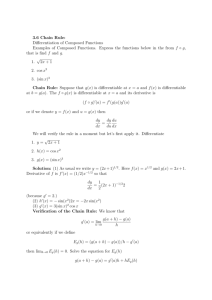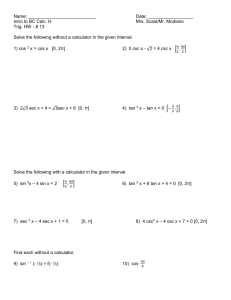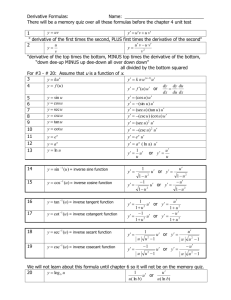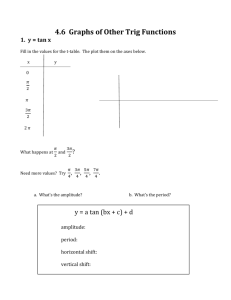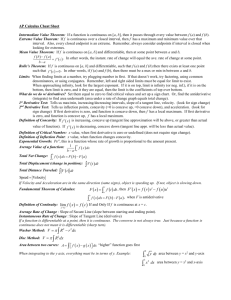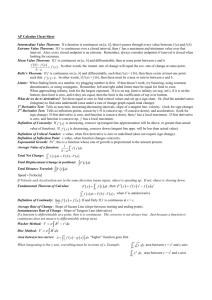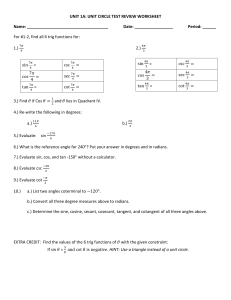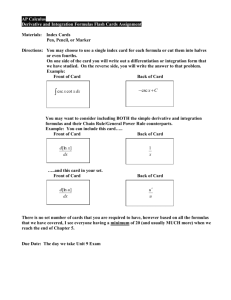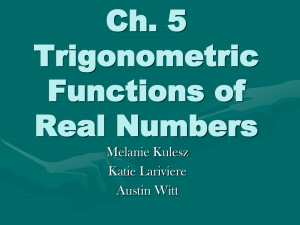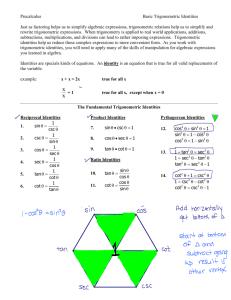Review of differentiation and integration rules from Calculus I and II
advertisement
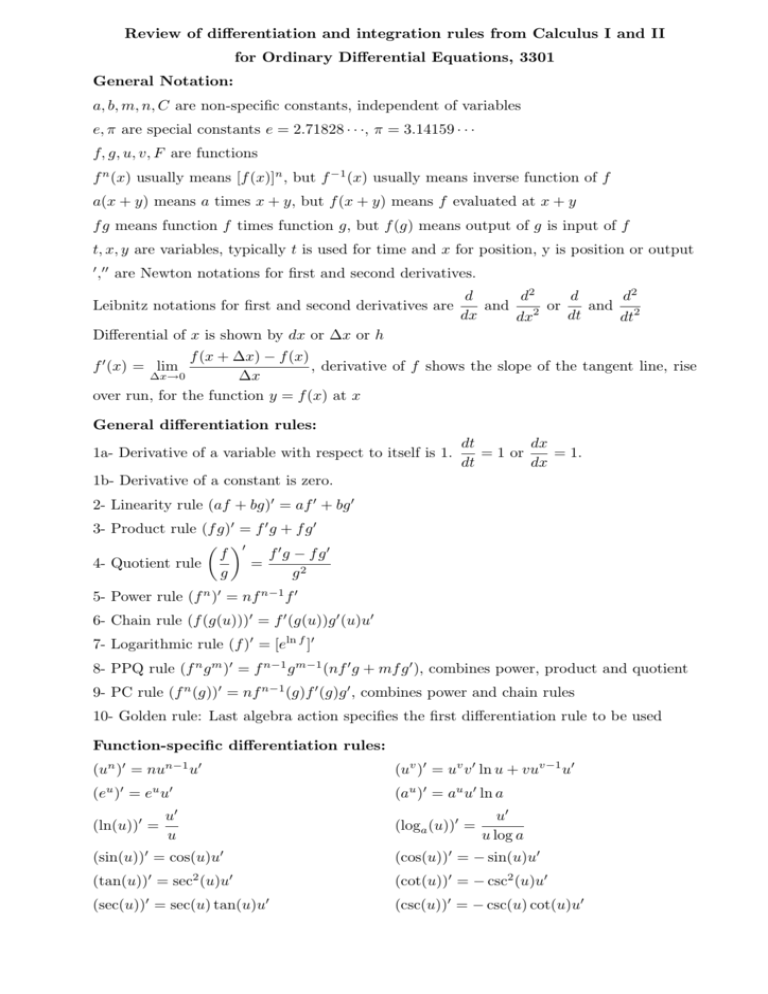
Review of differentiation and integration rules from Calculus I and II for Ordinary Differential Equations, 3301 General Notation: a, b, m, n, C are non-specific constants, independent of variables e, π are special constants e = 2.71828 · · ·, π = 3.14159 · · · f, g, u, v, F are functions f n (x) usually means [f (x)]n , but f −1 (x) usually means inverse function of f a(x + y) means a times x + y, but f (x + y) means f evaluated at x + y f g means function f times function g, but f (g) means output of g is input of f t, x, y are variables, typically t is used for time and x for position, y is position or output 0 00 , are Newton notations for first and second derivatives. Leibnitz notations for first and second derivatives are d2 d d2 d and or and dx dt dx2 dt2 Differential of x is shown by dx or ∆x or h f (x + ∆x) − f (x) , derivative of f shows the slope of the tangent line, rise ∆x→0 ∆x over run, for the function y = f (x) at x f 0 (x) = lim General differentiation rules: 1a- Derivative of a variable with respect to itself is 1. dt dx = 1 or = 1. dt dx 1b- Derivative of a constant is zero. 2- Linearity rule (af + bg)0 = af 0 + bg 0 3- Product rule (f g)0 = f 0 g + f g 0 µ ¶0 f 0 g − f g0 f = 4- Quotient rule g g2 5- Power rule (f n )0 = nf n−1 f 0 6- Chain rule (f (g(u)))0 = f 0 (g(u))g 0 (u)u0 7- Logarithmic rule (f )0 = [eln f ]0 8- PPQ rule (f n g m )0 = f n−1 g m−1 (nf 0 g + mf g 0 ), combines power, product and quotient 9- PC rule (f n (g))0 = nf n−1 (g)f 0 (g)g 0 , combines power and chain rules 10- Golden rule: Last algebra action specifies the first differentiation rule to be used Function-specific differentiation rules: (un )0 = nun−1 u0 (uv )0 = uv v 0 ln u + vuv−1 u0 (eu )0 = eu u0 (au )0 = au u0 ln a (ln(u))0 = u0 u (loga (u))0 = u0 u log a (sin(u))0 = cos(u)u0 (cos(u))0 = − sin(u)u0 (tan(u))0 = sec2 (u)u0 (cot(u))0 = − csc2 (u)u0 (sec(u))0 = sec(u) tan(u)u0 (csc(u))0 = − csc(u) cot(u)u0 u0 1 − u2 u0 (tan−1 (u))0 = 1 + u2 u0 (sec−1 (u))0 = √ u u2 − 1 (sin−1 (u))0 = √ −u0 1 − u2 −u0 (cot−1 (u))0 = 1 + u2 −u0 (csc−1 (u))0 = √ u u2 − 1 (cos−1 (u))0 = √ General integration definitions and methods: R 1- Indefinite integral f (x)dx = F (x) + C means F 0 (x) = f (x), F is antiderivative of f Rb 2- Definite integral a f (x)dx = F (b) − F (a) is area under y = f (x) from x = a to x = b R R R 3- Linearity (af + bg)dx = a f dx + b gdx R R 4a- Integration by parts f g 0 dx = f g − f 0 gdx R R 4b- Integration by parts udv = uv − vdu R R 5a- Indefinite integration by substitution f (g(x))g 0 (x)dx = f (u)du when u = g(x) Rb R g(b) 5b- Definite integration by substitution a f (g(x))g 0 (x)dx = g(a) f (u)du when u = g(x) 6- Integration by partial fraction decomposition 7- Integration by trigonometric substitution, reduction, circulation, etc 8- Study Chapter 7 of calculus text (Stewart’s) for more detail Some basic integration formulas: Z Z un+1 du n u du = + C, n 6= −1 = ln(u) + C n+1 u Z Z au u u +C e du = e + C au du = ln a Z Z cos(u)du = sin(u) + C sin(u)du = − cos(u) + C Z Z 2 sec (u)du = tan(u) + C csc2 (u)du = − cot(u) + C Z Z sec(u) tan(u)du = sec(u) + C csc(u) cot(u)du = − csc(u) + C Z Z tan(u)du = ln | sec(u)| + C cot(u)du = − ln | csc(u)| + C Z Z ³ ´ ³ ´ 1 1 1 −1 u −1 u √ du = tan + C du = sin +C u2 + a2 a a a a2 − u2 ¯ ¯ Z Z p ¯u − a¯ 1 1 1 ¯ ¯ √ du = ln du = ln |u + u2 ± a2 | + C + C 2 2 u2 − a2 2a ¯ u + a ¯ u ±a Z Z sec(u)du = ln | sec(u) + tan(u)| + C csc(u)du = ln | csc(u) − cot(u)| + C Z 1 sec3 (u)du = (sec(u) tan(u) + ln | sec(u) + tan(u)|) + C 2 Z 1 csc3 (u)du = (− csc(u) cot(u) + ln | csc(u) − cot(u)|) + C 2
